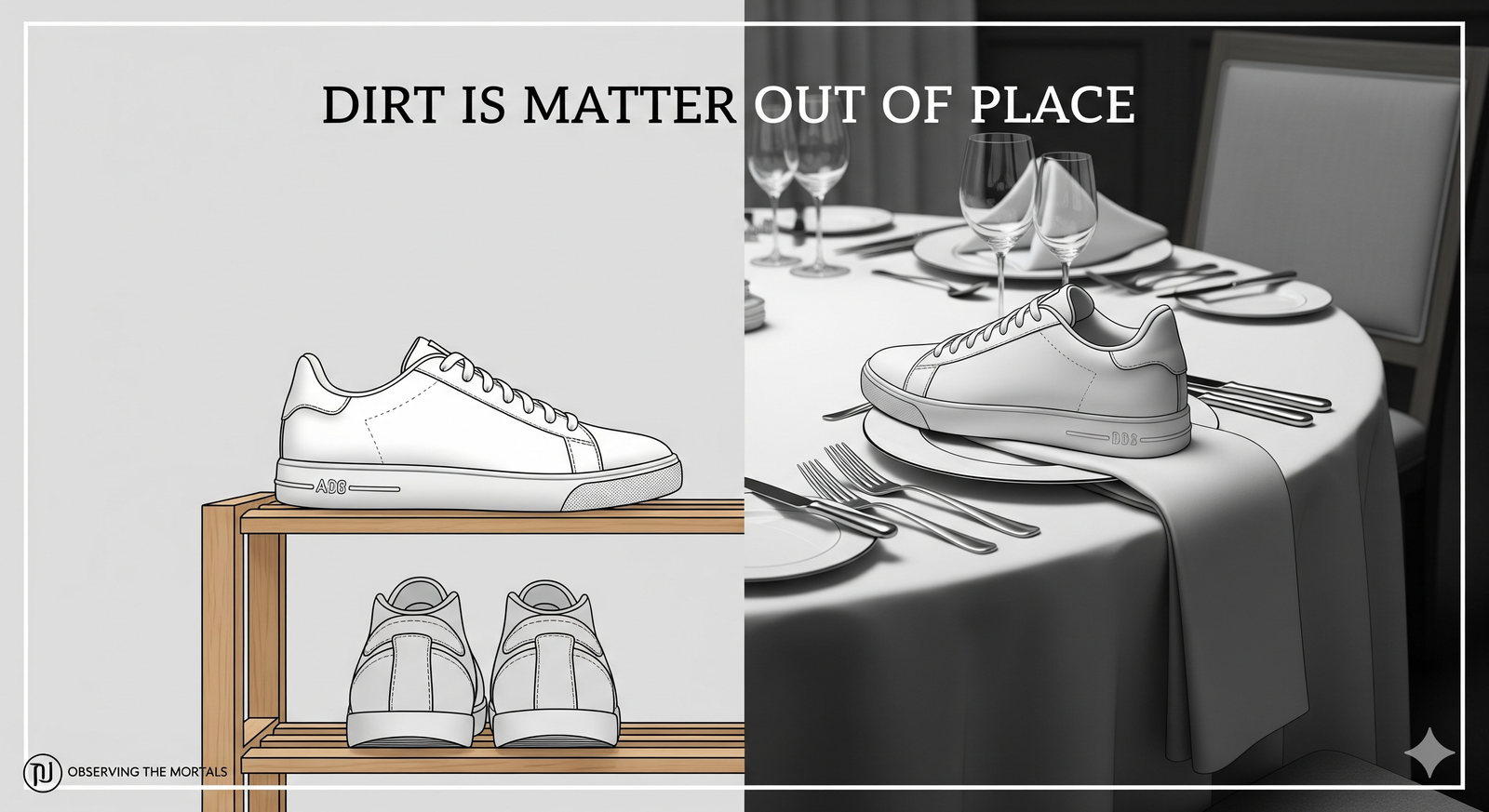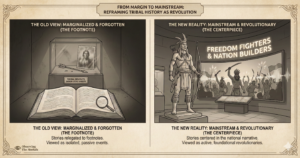Why do we find a shoe on a dining table so viscerally wrong, even if the shoe is brand new? Why have societies throughout history created complex, seemingly irrational rules about which foods are “clean” and which are “unclean”? In 1966, the brilliant British anthropologist Dame Mary Douglas offered a revolutionary answer that had very little to do with hygiene and everything to do with social order. She argued that our concept of dirt is not about germs, but about categories. This case study explores her masterpiece, Purity and Danger, and its enduring thesis that “dirt is matter out of place.”
The Information Box
Syllabus Connection:
- Paper 1: Chapter 5 (Anthropology of Religion: Taboo), Chapter 6 (Anthropological Theories: Structuralism), Chapter 2 (Social-Cultural Anthropology)
Key Concepts/Tags:
- Purity and Danger, Mary Douglas, Dirt as Matter out of Place, Structuralism, Pollution, Taboo
The Setting: Who, What, Where?
This is a towering work of theoretical anthropology by Dame Mary Douglas, a leading figure in the British Social Anthropology tradition and a student of E.E. Evans-Pritchard. Her analysis was published in her 1966 book, Purity and Danger: An Analysis of Concepts of Pollution and Taboo. This is not a single-site ethnography but a comparative work that synthesizes a vast range of cultural data, from her own fieldwork among the Lele people of Congo to, most famously, a groundbreaking re-interpretation of the dietary laws in the Book of Leviticus from the Old Testament.
The Core Argument: Why This Study Matters
Douglas’s work fundamentally changed how anthropologists understood concepts of cleanliness and defilement. She argued that these are not universal scientific facts, but powerful symbolic systems for ordering the world.
- The Revolutionary Thesis: Dirt is “Matter Out of Place”: This is the elegant, powerful heart of her argument. What we consider “dirt” is not defined by its physical properties, but by its violation of our deeply held systems of classification. A shoe is perfectly fine on the floor, but it becomes “dirty” and offensive on a dinner table because it transgresses the boundary of where a shoe belongs. Therefore, our rituals of cleaning are rituals of re-ordering our world and reinforcing its proper categories.
- Purity, Pollution, and Social Order: Following this logic, rules about purity and pollution are fundamentally about maintaining the symbolic and social boundaries of a society. Things that are ambiguous, that cross boundaries, or that do not fit neatly into our classification system (e.g., bodily fluids that exit the body, amphibians that are neither land nor water creatures) are often considered powerful, dangerous, and polluting. Taboos and pollution rules are the fences a society builds to protect its worldview.
- The Case of the Abominable Pig: Douglas’s most famous example is her analysis of the pork taboo in the Book of Leviticus. She dismissed the common explanation of hygiene. Instead, she argued that the pig is forbidden because it is a categorical anomaly. According to the ancient Hebrew classification system, a proper animal for consumption should have a cloven hoof and chew the cud (like cattle and sheep). The pig has a cloven hoof, but it does not chew the cud. It defies the neat, God-given categories of the world. Because it is an ambiguous, boundary-crossing creature, it is declared “unclean”—it is matter out of place.
The Anthropologist’s Gaze: A Critical Perspective
- Is the Model Too Rigid?: Critics of structuralism, the school to which Douglas belongs, argue that this model can be overly formal and static. It presents a society’s classification system as a neat, fixed blueprint and may not fully capture how these rules are contested, bent, or changed by individuals in their everyday lives.
- Downplaying Materialist Factors: By focusing so heavily on the symbolic order, does the theory ignore more materialist or ecological explanations? The anthropologist Marvin Harris, for example, famously argued that the Middle Eastern pig taboo had an ecological basis (pigs are ill-suited to arid climates and compete with humans for food), rather than a purely symbolic one.
- The “Insider” vs. “Outsider” View: Does the model truly capture what a taboo means to the people who practice it, or is it an external, intellectualist explanation imposed by the anthropologist? A religious practitioner might explain the pig taboo by simply stating, “Because God commanded it,” not because it’s a categorical anomaly.
The Exam Angle: How to Use This in Your Mains Answer
- Types of Questions Where It Can be Used:
- “What do you understand by the concepts of purity, pollution, and taboo in the anthropology of religion?”
- “Critically evaluate the contributions of the structuralist school of thought in anthropology.”
- “Religious beliefs are based on a coherent symbolic logic. Discuss with examples.”
- Model Integration:
- On Purity and Pollution: “Mary Douglas, in her seminal work ‘Purity and Danger,’ provided a structuralist interpretation of pollution. She argued that concepts of dirt are not based on hygiene but on order, famously defining dirt as ‘matter out of place.’ Thus, pollution rules function to maintain a society’s symbolic and social boundaries.”
- On Taboo: “The logic behind food taboos can be understood symbolically. For instance, Mary Douglas explained the Biblical prohibition on eating pork not in terms of health, but by arguing that the pig was a ‘categorical anomaly’ that violated the ancient Hebrew classification of the natural world, and was therefore declared dangerously ‘unclean’.”
- To offer a critique of Structuralism: “While structuralist models like Mary Douglas’s provide elegant explanations for cultural rules, they have been critiqued for being overly rigid and for downplaying the agency of individuals or the material factors, such as ecology, that also shape cultural practices.”
Observer’s Take
The genius of Mary Douglas’s work is its ability to find a universal, underlying logic in a set of human behaviors that often seem irrational or archaic. She revealed that our deep-seated reactions to “dirt,” our complex rituals of cleaning, and our sacred taboos are not arbitrary; they are the invisible scaffolding that holds our social and symbolic worlds together. Her core idea—that in creating order, we inevitably create “dirt”—is a profound insight into the human condition itself. Purity and Danger teaches us that to truly understand a society, we must look not only at what it embraces and values, but at what it fears, rejects, and casts out as unclean.





